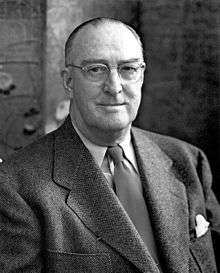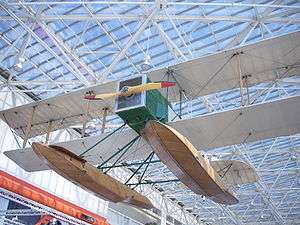William Boeing
| William Boeing | |
|---|---|
 | |
| Born |
William Edward Boeing October 1, 1881 Detroit, Michigan |
| Died |
September 28, 1956 (aged 74) Seattle, Washington |
| Nationality | American |
| Alma mater | Yale University |
| Occupation | Industrialist |
| Known for | Aircraft industry |
| Title | Founder of Boeing Company |
| Awards | Daniel Guggenheim Medal (1934) |
William Edward Boeing (/ˈboʊɪŋ/; October 1, 1881 – September 28, 1956) was an American aviation pioneer who founded The Boeing Company.
Biography
W. E. Boeing was born in Detroit, Michigan, to Catholic parents,[1] a wealthy mining engineer named Wilhelm Böing from Hagen-Hohenlimburg, Germany, and Marie M. Ortmann from Vienna, Austria. Boeing Sr. had made a fortune from timber lands and mineral rights near Lake Superior.[2] Anglicizing his name to "William Boeing" after returning from being educated in Vevey, Switzerland in 1900 to attend Yale University,[3] William Boeing left Yale before graduating, in 1903 to go into the lumber side of the business. He moved to Hoquiam, Washington state, and purchased extensive timberlands around Grays Harbor on the Pacific side of the Olympic Peninsula and also bought into lumber operations. He made a success of the venture, in part by shipping lumber to the East Coast via the new Panama Canal, generating funds that he would later apply to a very different business.[4]
While president of Greenwood Timber Company, Boeing, who had experimented with boat design, traveled to Seattle, where, during the Alaska-Yukon-Pacific Exposition in 1909, he saw a manned flying machine for the first time and became fascinated with aircraft. Boeing decided to take lessons at the Glenn L. Martin Flying School in Los Angeles and he purchased one of Martin's planes.[5] Martin pilot James Floyd Smith traveled to Seattle to assemble Boeing's new Martin TA hydroaeroplane and continue to teach its owner to fly. Huge crates arrived by train, and Smith assembled the plane in a tent hangar erected on the shore of Lake Union. William Boeing became a pilot. Boeing's test pilot, Herb Munter, soon cracked up the plane. When he was told by Martin that replacement parts would not become available for months, Boeing told his friend Cdr. George Conrad Westervelt (USN), "We could build a better plane ourselves and build it faster". Westervelt agreed. They soon built and flew the B & W Seaplane, an amphibian biplane that had outstanding performance. Boeing decided to go into the aircraft business and bought an old boat works on the Duwamish River near Seattle for his factory.

Founding of Boeing Aircraft
In 1916, Boeing went into business with George Conrad Westervelt as B & W and founded the Pacific Aero Products Co. The company's first plane was the Boeing Model 1 (B & W Seaplane). When America entered the First World War on April 8, 1917, a little more than a month later, Boeing changed the name from Pacific Aero Products Co. to Boeing Airplane Company[6] and obtained orders from the United States Navy for 50 planes. At the end of the war, Boeing began to concentrate on commercial aircraft, secured contracts to supply airmail service and built a successful airmail operation and later passenger service that evolved into United Airlines.
Boeing family
In 1921, William Boeing married Bertha Marie Potter Paschall (1891-1977). She had previously been married to Nathaniel Paschall, a real estate broker with whom she bore two sons, Nathaniel "Nat" Paschall Jr. and Cranston Paschall. These two sons became Boeing's stepsons. The couple had a son of their own, William E. Boeing Jr. The stepsons went into aviation manufacturing as a career. Nat Paschall was a sales manager for Douglas Aircraft and then McDonnell Douglas. William E. Boeing Jr. became a noted private pilot and industrial real estate developer.
Bertha Potter Paschall Boeing was the daughter of Howard Cranston Potter and Alice Kershaw Potter. Through her father, Bertha was a descendant of merchant bankers Alexander Brown of Baltimore, James Brown and Brown's son-in-law and partner Howard Potter of New York; and through her mother, the granddaughter of Charles James Kershaw and Mary Leavenworth Kershaw (a descendant of Henry Leavenworth).
Break up of Boeing Group
In 1934, the United States government accused William Boeing of monopolistic practices. The same year, the Air Mail Act forced airplane companies to separate flight operations from development and manufacturing. William Boeing divested himself of ownership as his holding company, United Aircraft and Transport Corporation, broke into three separate entities:
- United Aircraft Corporation, holding the former eastern US manufacturing (now United Technologies Corporation)
- Boeing Airplane Company, with western US manufacturing, which later became The Boeing Company
- United Air Lines for flight operations
He began investing most of his time in his horses in 1937. Boeing Airplane Company, though a major manufacturer in a fragmented industry, did not really become successful until the beginning of World War II.
Later life
Between 1935 and 1944, William Boeing and his wife Bertha set aside a large tract of land north of the Seattle city limits for subdivision, including the future communities of Richmond Beach, Richmond Heights, Innis Arden, Blue Ridge and Shoreview.[7] The Boeings placed racially restrictive covenants on their land to enforce segregation, forbidding properties from being "sold, conveyed, rented, or leased in whole or in part to any person not of the White or Caucasian race." Non-whites could only occupy a property on the land if they were employed as a domestic servant "by a person of the White or Caucasian race."[7][8]
Boeing retired from the aircraft industry. He then spent the remainder of his years in property development and thoroughbred horse breeding. Concerned about the possibility of World War II battles in the Pacific Northwest, he purchased a 650-acre (260 ha) farm in the countryside east of Seattle, which he dubbed "Aldarra". The estate remained in the family until most of the land was sold and developed into a golf course in 2001.[9] Several acres, however, remained in the family, including the Boeing's own and two smaller houses. His primary residence for most of his life, however, was a mansion in The Highlands community close to Seattle; the William E. Boeing House was later listed on the National Register of Historic Places.[10] Boeing Creek running near this property bears his name.
William Boeing died on September 28, 1956, at the age of 74, just three days before his 75th birthday, and a year before the first successful commercial jet airliner, the Boeing 707, would take its first flight. He was pronounced dead on arrival at the Seattle Yacht Club, having had a heart attack aboard his yacht.[11] His ashes were scattered off the coast of British Columbia, where he spent much of his time sailing the Taconite, his yacht.[12]
He was posthumously inducted into the Aviation Hall of Fame in Dayton, Ohio, in 1966.[5]
See also
References
- ↑ http://historyboeing.yolasite.com/william-boeing.php
- ↑ "Biography of William E. Boeing" (PDF). Boeing.
- ↑ From the PBS documentary "Pioneers in Aviation: The Race for the Moon Episode I; The Early Years"
- ↑ The Panama Canal's unexpected winners, BBC Mundo, 4 July 2016
- 1 2 Schefke, Brian. "William Edward Boeing." In Immigrant Entrepreneurship: German-American Business Biographies, 1720 to the Present, vol. 4, edited by Jeffrey Fear. German Historical Institute. Last modified June 03, 2016.
- ↑ "Biography of William E. Boeing" (PDF). Boeing.
- 1 2 Taylor, Dorceta E. (2014). Toxic Communities. New York: New York University Press. p. 203. ISBN 978-1-479-86178-1.
- ↑ Turnbull, Lornet (June 3, 2005). "Homeowners find records still hold blot of racism". The Seattle Times. Retrieved April 15, 2016.
- ↑ Raley, Dan (April 23, 2001). "From The Bunkers: It's an exclusive: Aldarra opens on May 4". Seattle Post-Intelligencer.
- ↑ "William E. Boeing House". National Park Service. Retrieved 2013-01-11.
- ↑ "William Boeing, Plane Pioneer, 74. Founder of Coast Concern Dies at 74. Guggenheim Award Winner in '34.". The New York Times. Associated Press. September 29, 1956. Retrieved 2009-06-30.
William E. Boeing, founder of the company that now makes this country's biggest jet bombers, died unexpectedly today aboard his yacht. He was 74 years old.
- ↑ "Executive Biography of William E. Boeing: Expanded William Boeing biography (PDF)". Boeing. Retrieved 2016-05-12.
William E. Boeing died September 28, 1956, aboard the Taconite. ...his family scattered his ashes into the sea off the coast of British Columbia where he had spent so many months aboard the Taconite.
Further reading
- Carl Cleveland, Boeing Trivia, (Seattle: CMC Books, 1989)
- Harold Mansfield, Vision: A Saga of the Sky (Duell, Sloan and Pearce, 1956)
- Robert Serling, Legend & Legacy: The Story of Boeing and Its People (New York: St. Martin's Press, 1992)